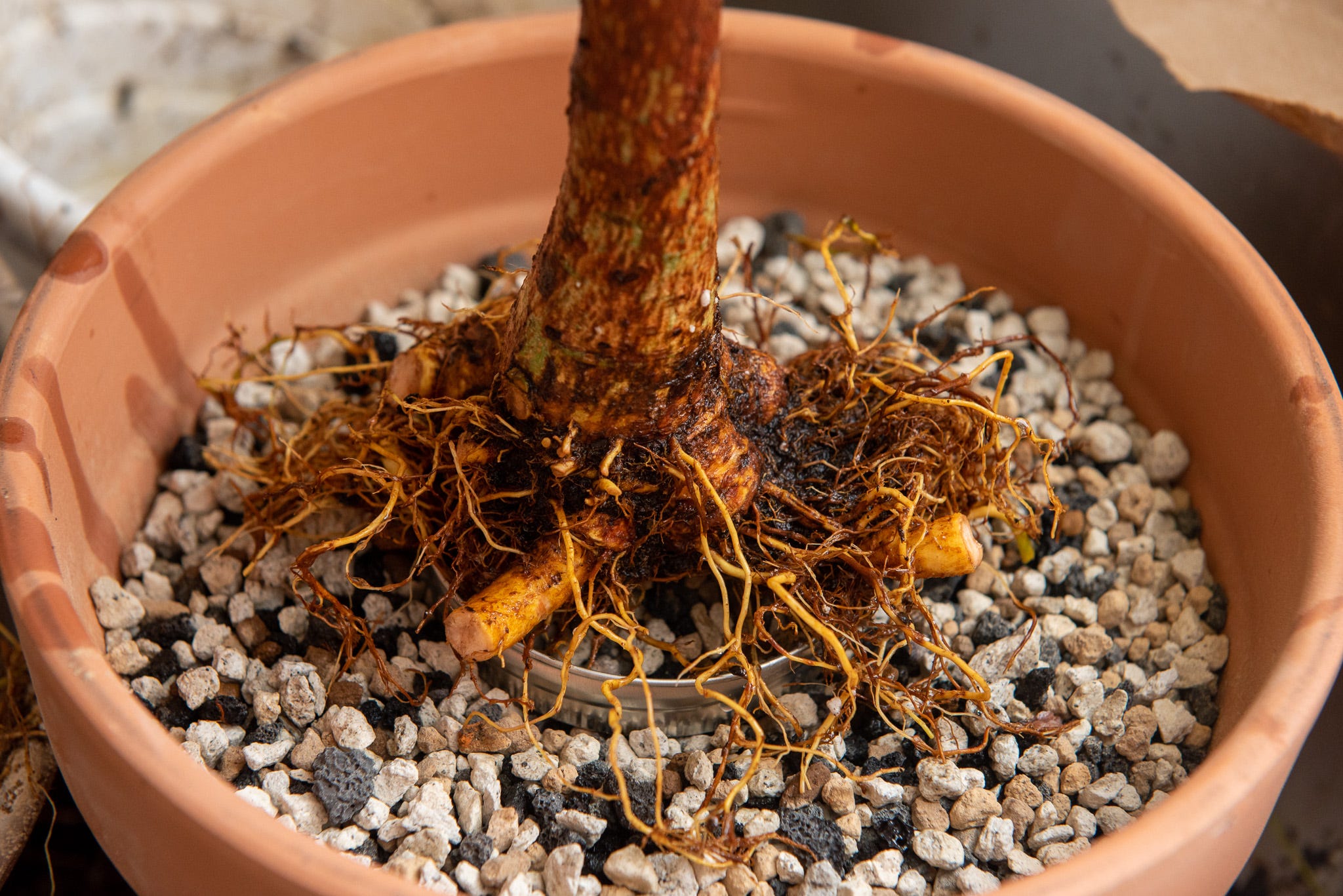Bonsai is not inherently cruel if done correctly. Proper care ensures the tree remains healthy and thrives.
Bonsai is the art of cultivating miniature trees that mimic the shape and scale of full-sized trees. Originating in China and popularized in Japan, bonsai involves meticulous pruning, wiring, and potting techniques. Enthusiasts often invest significant time and effort in maintaining their bonsai trees.
Proper care includes adequate watering, appropriate sunlight, and suitable soil conditions. Critics argue that restricting a tree’s growth is unnatural. However, with responsible practices, bonsai trees can live long, healthy lives. The key lies in understanding the tree’s needs and providing the necessary care. Bonsai can be a rewarding hobby that teaches patience and respect for nature.

Credit: www.reddit.com
History Of Bonsai
The history of Bonsai spans many centuries. This ancient art has roots in various cultures. Understanding its background helps clarify if Bonsai is cruel.
Ancient Origins
The term Bonsai comes from the Japanese words “bon” and “sai.” It means a tree planted in a shallow container. This practice began in China over a thousand years ago. The Chinese called it Penjing, and it involved creating miniature landscapes. These landscapes often included trees, rocks, and water elements.
Bonsai then traveled from China to Japan. Japanese monks brought the art form with them. In Japan, it evolved into the Bonsai we know today. The focus shifted to single trees rather than entire landscapes. This change made Bonsai more accessible and popular.
Cultural Significance
Bonsai holds deep cultural importance in Japan. It symbolizes harmony, balance, and patience. For centuries, it was a practice enjoyed by the wealthy and the noble class. These miniature trees were often displayed in homes and gardens.
Over time, Bonsai became a symbol of peace and order. The care required to cultivate a Bonsai tree teaches patience. It also reflects the beauty of nature in a controlled form. This cultural significance contributes to the debate on whether Bonsai is cruel.
Today, Bonsai is practiced worldwide. Its cultural roots remain strong, and its history is celebrated by enthusiasts everywhere.

Credit: fireescapebonsai.substack.com
Bonsai Techniques
Bonsai techniques are essential for shaping these miniature trees. These methods involve careful pruning and shaping. Here, we delve into two primary techniques: pruning methods and wiring and shaping.
Pruning Methods
Pruning keeps the bonsai tree small and healthy. Regular trimming encourages new growth and maintains the desired shape.
- Maintenance Pruning: This involves trimming new shoots. It ensures the tree keeps its shape.
- Structural Pruning: This is done less frequently. It shapes the tree’s main structure.
Pruning tools include small shears and scissors. Clean tools prevent disease.
Wiring And Shaping
Wiring helps in shaping the bonsai tree. Wires guide branches to grow in specific directions.
- Choose the Right Wire: Use aluminum or copper wire. These materials are flexible and strong.
- Wrap the Wire: Wrap the wire around the branches gently. Do not wrap too tightly.
- Bend and Shape: Bend the branches slowly. Shape them to the desired form.
Wiring should be removed after a few months. This prevents damage to the branches.
Care And Maintenance
The art of Bonsai requires detailed care and maintenance. Proper attention ensures the health and beauty of these miniature trees. Below, we explore essential practices for watering and nutrient needs.
Watering Practices
Bonsai trees need precise watering to thrive. Overwatering can cause root rot, while underwatering leads to dehydration. Here are some key practices to follow:
- Check soil moisture: Use your fingers to feel the soil. It should be slightly damp.
- Watering frequency: Typically, water your Bonsai once a day. Adjust based on the season and climate.
- Watering method: Use a gentle spray to avoid soil erosion. Ensure water reaches the roots.
Nutrient Requirements
Bonsai trees also need nutrients to stay healthy. They require a balanced diet of essential elements. Understanding their nutrient needs helps in proper care:
- Fertilizers: Use a balanced fertilizer with equal NPK (Nitrogen, Phosphorus, Potassium) ratio.
- Application frequency: Feed your Bonsai every two weeks during the growing season.
- Organic options: Consider organic fertilizers for a natural nutrient boost.
By following these care and maintenance tips, your Bonsai will flourish and remain healthy.
Ethical Considerations
Many people wonder if practicing bonsai is ethical. They question the impact on plant welfare and the environment. Understanding these concerns can help us make informed decisions.
Plant Welfare
Bonsai is the art of growing miniature trees. These trees are kept small through pruning and wiring. Some people believe this is harmful to the plants. But, bonsai trees can live very long lives.
They often outlive their wild counterparts. Proper care is crucial for their health. This includes regular watering, fertilizing, and repotting. Neglect can harm these delicate plants. Yet, with care, bonsai trees thrive and even flourish.
- Pruning: Helps shape the tree and encourages new growth.
- Wiring: Guides branches into the desired position.
- Repotting: Ensures the tree has fresh soil and space.
Environmental Impact
Growing bonsai can have positive effects on the environment. Bonsai trees are small but still perform photosynthesis. This process helps clean the air by absorbing carbon dioxide.
Bonsai cultivation promotes an appreciation for nature. It can inspire people to care for the environment. Many bonsai enthusiasts use organic methods to care for their trees. This reduces the use of harmful chemicals.
| Positive Impact | Details |
|---|---|
| Air Quality | Bonsai trees absorb carbon dioxide and release oxygen. |
| Environmental Awareness | Encourages a deeper connection with nature. |
| Organic Practices | Reduces the use of harmful chemicals. |
Proper bonsai care can help create a sustainable hobby. It teaches patience and respect for living things. These small trees remind us of the beauty and importance of nature.
Common Misconceptions
Many people think bonsai trees are treated cruelly. This is not true. Let’s clear up some common misconceptions about bonsai care.
Growth Stunting Myths
People often believe bonsai trees are stunted. They think this stunting is harmful to the tree. This is a myth. Bonsai trees are kept small through careful pruning. This does not hurt the tree.
Another myth is that bonsai trees are unhealthy. In reality, bonsai trees can live for hundreds of years. They are healthy and well-cared for.
Natural Vs. Artificial
Many think bonsai trees are unnatural. This is not true. Bonsai trees grow naturally, like any other tree. They are just shaped differently.
Some people believe bonsai trees are fake. This is also false. Bonsai trees are real, living trees. They need water, sunlight, and care to thrive.
In summary, bonsai cultivation is an art. It requires skill and patience. It is not cruel but a way to appreciate nature.

Credit: www.bonsaisanctum.com
Benefits Of Bonsai
Bonsai is more than growing small trees. It brings many benefits. People of all ages can enjoy bonsai. It helps in many ways. Let’s explore the benefits of bonsai.
Mental Health
Bonsai helps with mental health. Caring for a bonsai tree calms the mind. It reduces stress. Watching a bonsai grow is relaxing. It helps people feel happy and peaceful.
Gardening with bonsai improves focus. It helps keep the mind sharp. People feel proud when their bonsai grows well. This boosts self-esteem. Bonsai can be a quiet escape from busy life.
Educational Value
Bonsai has great educational value. It teaches patience. Bonsai trees grow very slowly. Watching them grow teaches the value of time.
Kids learn about nature with bonsai. They understand how plants grow. Bonsai also teaches responsibility. Kids learn to take care of their trees.
| Benefit | Description |
|---|---|
| Science | Kids learn about plant biology. |
| Art | Bonsai involves creativity and design. |
| Math | Kids measure and track growth. |
Learning with bonsai is fun. It combines science, art, and math. Kids and adults both can enjoy and learn.
Voices From The Community
The world of bonsai is filled with diverse opinions. Some see it as an art form, while others question its ethics. To understand this better, let’s explore the voices from the community.
Experts’ Opinions
Experts have shared their thoughts on bonsai cultivation. Many believe it is a respectful art. They argue that bonsai trees receive more care than wild trees. This care includes regular watering, pruning, and soil management. Some experts state that bonsai trees live longer than their wild counterparts.
Other experts raise concerns about bonsai practices. They worry that restricting a tree’s growth can be harmful. They point out that some techniques may cause stress to the tree. These experts call for more research into the long-term effects of bonsai cultivation.
Practitioners’ Insights
Bonsai practitioners provide another perspective. Many bonsai enthusiasts view their practice as a form of meditation. They find joy in nurturing their trees and witnessing their growth. They argue that bonsai trees, when well cared for, can thrive.
Some practitioners share their methods to ensure tree health. They use high-quality soil, ensure proper drainage, and avoid over-pruning. These practices help maintain the tree’s well-being. Practitioners also emphasize the importance of understanding each tree species.
| Aspect | Expert View | Practitioner View |
|---|---|---|
| Care | Receive more care | Joy in nurturing |
| Longevity | Live longer | Can thrive when cared for |
| Concerns | Stress and harm | Proper methods ensure health |
- Bonsai is seen as an art and a science.
- Experts and practitioners offer varied insights.
- Both groups emphasize the importance of care.
Conclusion
Bonsai is not inherently cruel if done with care and respect for the tree. Proper techniques ensure the plant thrives. Always consider the tree’s needs and provide appropriate care. Bonsai can be a beautiful art form that promotes a deep connection with nature.
Choose ethical practices to enjoy bonsai responsibly.

